The Artwork in Ace Egos
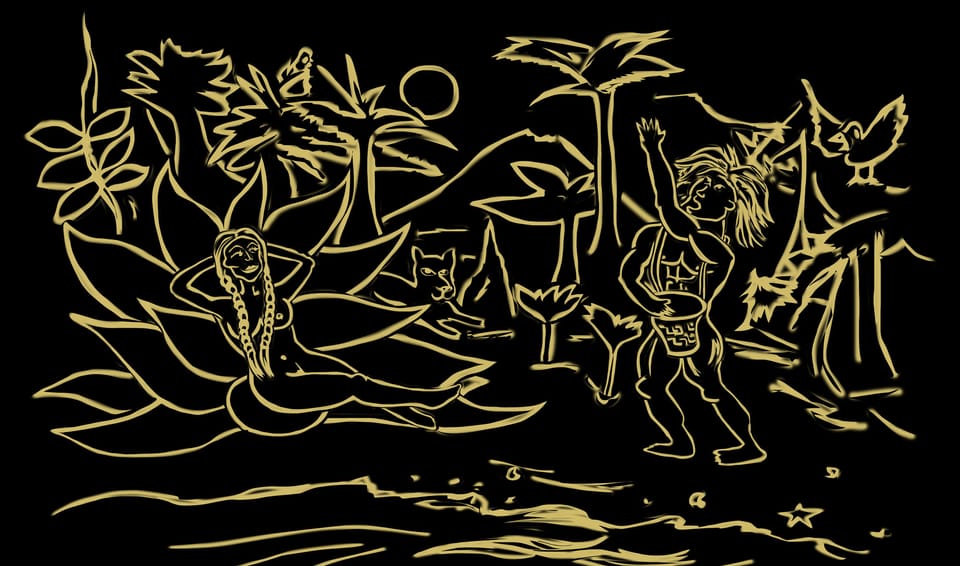
‘It was almost overcome, but it was mostly overcoming. I had been held aloft in one instant; and in the other banished to the desert, naked and lost. Pride. It could make or break you. Out of the mirage of my pride emerged elephants taller than giraffes, with insect legs slowly trampling through the sand, carrying away pieces of myself residing inside golden palaces upon their backs.’ ~ from my book, Ace Egos
A Picture of Words
Life is detailed. ‘Story’ arranges the details of life’s experiences. Story takes these details and paints pictures, that we attach meaning to. It is the details in a book that places the reader deep inside a scene, with more to observe, more connections to establish, and more life shaped into the writing. It follows then, that to describe artwork – which are visual depictions of story-telling – within a written work, imbues that writing with multiple layers, rich with interpretations.
Unexpectedly, I found myself reading Deliver Us From Evil by David Baldacci, a thriller novel about agents catching bad guys, and was drawn to many facets of it. It is the part about an art exhibition of Spanish artist Francisco Goya, hosted near the Alpilles mountains of Southern France, that really captivated me, that took me into the book’s world. In happy reflection, I realised this is what I have been doing in my book Ace Egos. It is set in Europe, and alludes to periods when painting, music and mysticism were accepted and integral to human pursuits. Callum, the main character of my book, tends to dramatise moments of inner turmoil and external challenge, by comparing his state of mind to famous artworks.
The main plot of the book is: Rockstar drummer Callum Langdon inherits a deck of magic playing cards, and begins a quest to try and unlock its secrets, to help an ancient Basque tradition be restored, connected to rebalancing harmony in the world. These cards also start to show Callum how to discover the truth of the soul, that we bury deep beneath the shadows of ourselves. I am almost halfway through writing the first draft. So far, Callum’s Rock n’ Roll band travels through Spain, France, Belgium, Netherlands and Germany. Along the way, Callum’s mind conjures up images of paintings of the Renaissance, Expressionism, Surrealism, and Minimalism.
Viewing the Gallery
In this article, I will share five artworks that appear at significant points in the book. In some ways, this captures a truncated version of painting’s evolution through celebrated ‘Art movements’ in Europe, which sprung up in response to societal and cultural behaviours of the time. So, let’s take the tour. Let’s do a little slow looking.
Adoration of the Mystic Lamb (More commonly known as The Ghent Altarpiece) – 1432
Artists: The brothers Hubert and Jan van Eyck
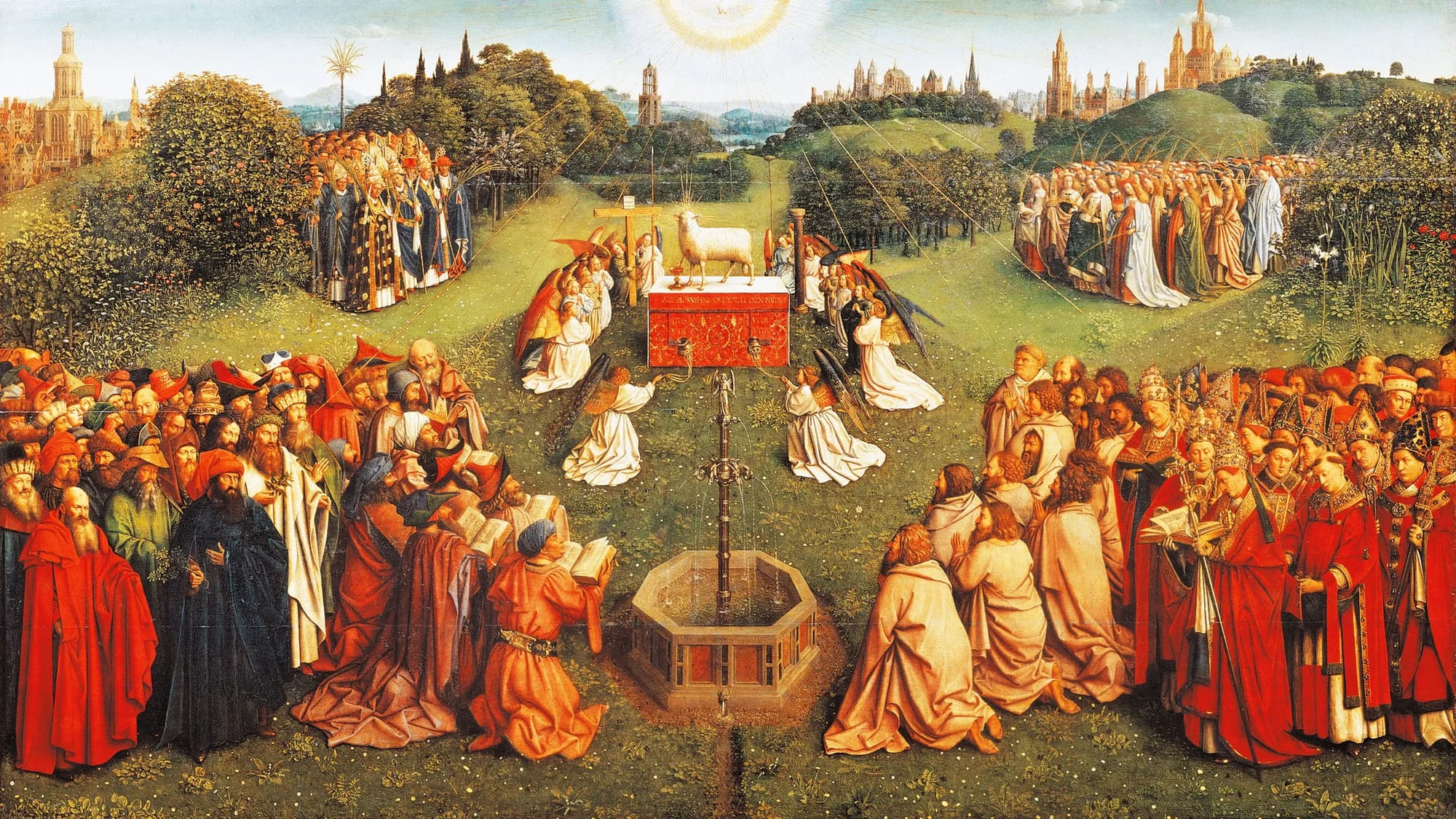
In my ‘real life,’ around 2008, my band lived in Europe, and spent a lot of time in Ghent. We found family in the people, the local communities, and especially with one man who took us under his wing, and instantly became a dear friend. His generosity and his factor of cool is beyond any human I’ve ever met. I based a character in the book – Hawk – on him.
We were lucky to play a few shows at the Gentse Feesten, which is a wild ten-day celebration, where I believe more hardcore beers (all with brand names that have something to do with monks or evil) are consumed than anywhere else in the Universe. In the heart of the city of Ghent is a breath-taking church named St. Bavo's Cathedral. The altarpiece inside is a divine painting that spans across 15 panels. The rectangular panel in the center is where the artwork's name comes from, as a gathering of saints, sinners, and other folk sit before the adoration of the Lamb of God. The painting is grand, but is overly crowded with characters. This is something Callum’s innocent mind notes, reminding him of some of Bosch’s paintings.
The Garden of Earthly Delights – 1490-1510
Artist: Hieronymus Bosch
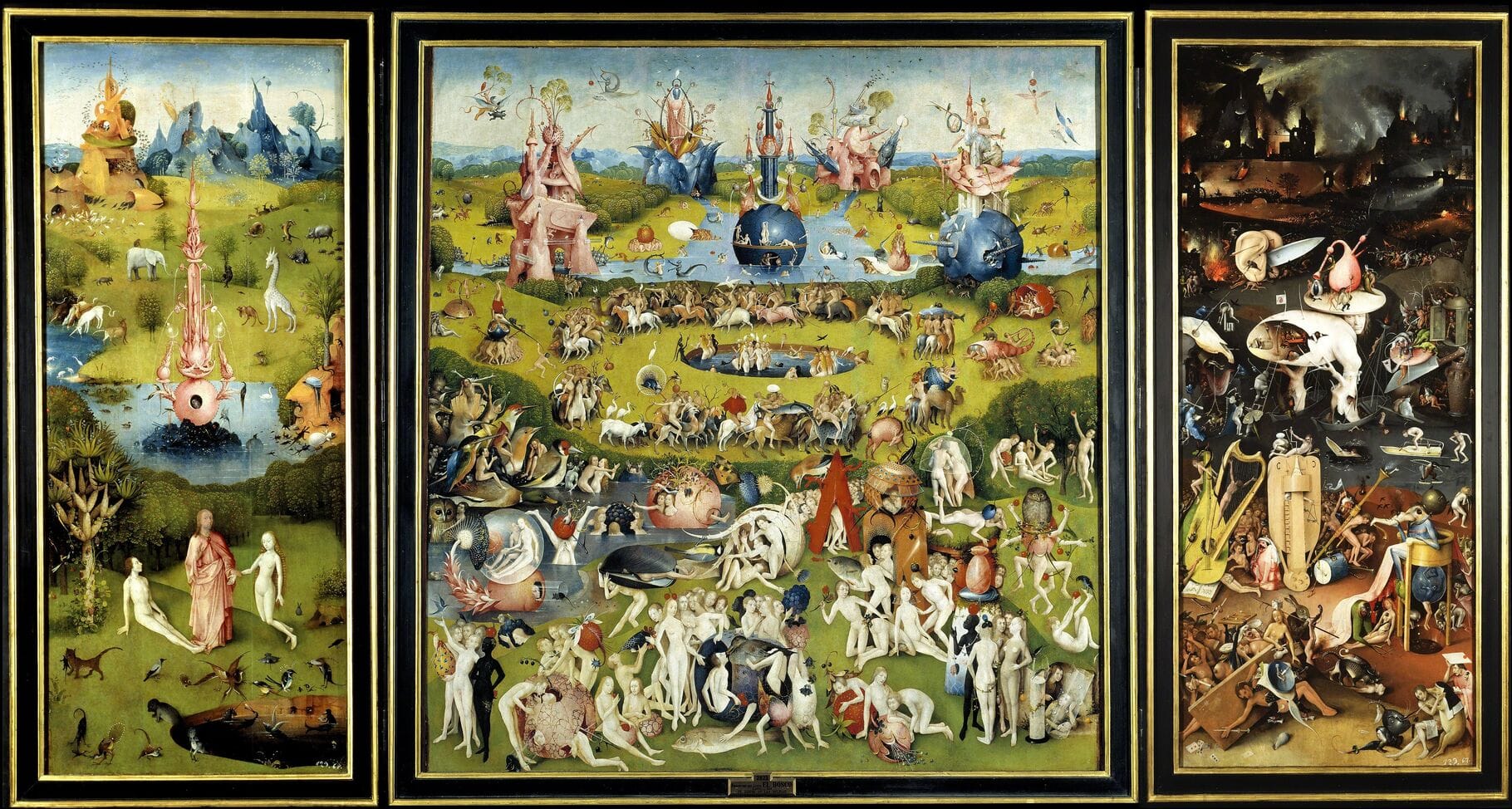
Bosch’s imagery is what arises in Callum’s inner view when he sees the outdoor activity of the Gentse Feesten. I wrote this mixing together a few memories. One is, obviously, the Ghent Festival itself, where the city is filled with people. It is most chaotic at night, because people are drunker and rowdier. Ghent is a town with a lot of squares, large outdoor areas that are like royal courtyards. On a regular day, people might be hanging out by water fountains, or having coffee and pastry seated outside of a cafe. Classic European ambiance.
The other part of my memory was one show my band played in Barcelona. It was inside a clothing store, called ‘Rock n’ Roll Circus.’ It had a freakshow vibe to it. Outside, it was the Gràcia Festival (Festa Major de Gràcia), in a trendy area of the city; a six-day and night whimsy of food, music, dance, and art. On the evening of August 21 they do a ‘fire run,’ or correfoc in Catalan, where devil-masked deviants run up the streets letting off fireworks, especially at those who dare to get too close. It’s rooted in an old Catalan tradition of ‘devil dances’ (Ball de Diables), which symbolises the fight of good and evil. I wasn’t able to squash this awesome experience into the book, so it got morphed into the description of the Gentse Feesten. And since Bosch’s work is all about ominous hellishness, it seemed fitting to be the image that begins Callum’s spiral into more horrific encounters on his journey.
The Scream – 1893
Artist: Edvard Munch
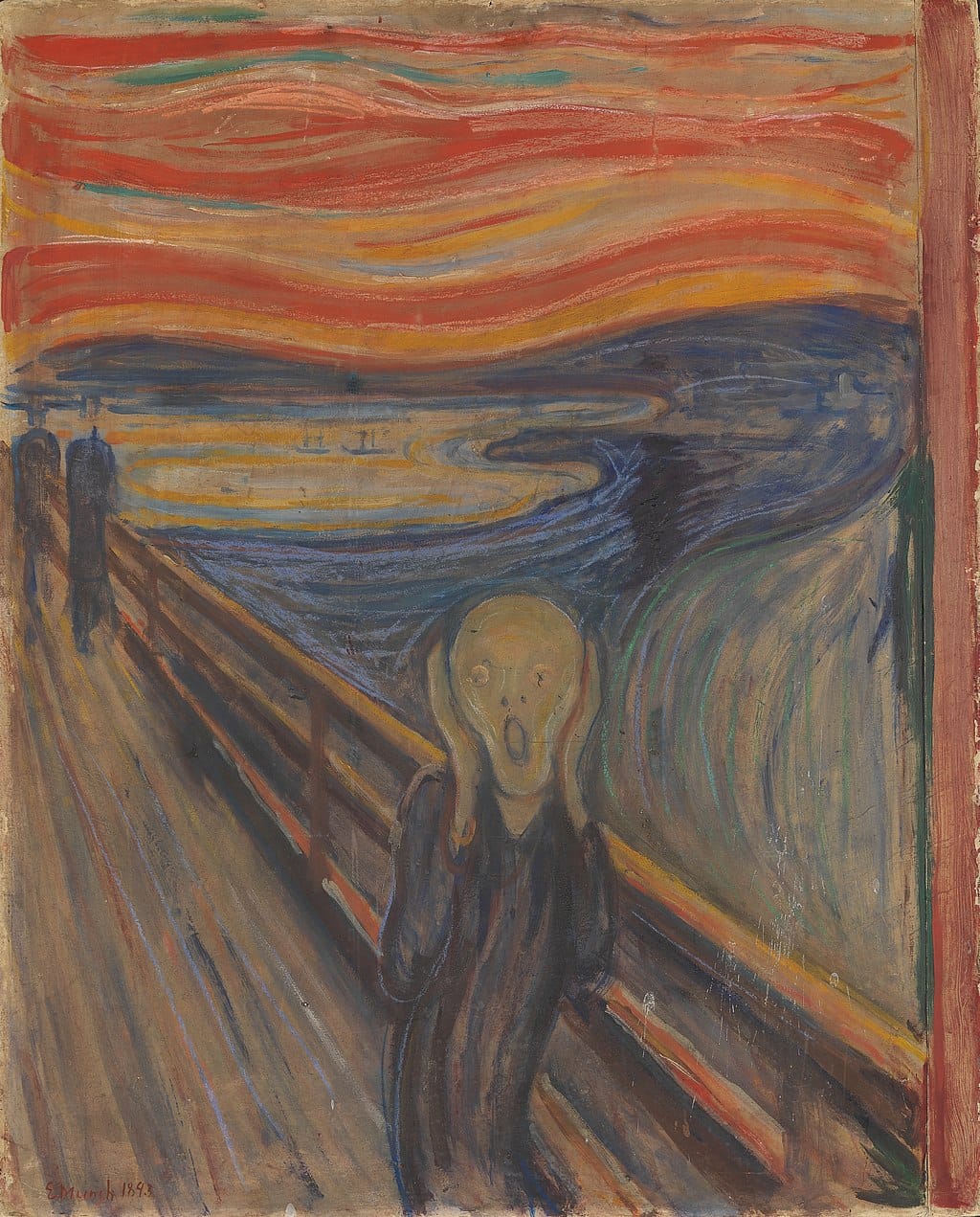
At the peak of Callum’s delirium he recalls one of the most famous artworks in history. Edvard Munch painted this as an expression he felt in response to the powerful natural forces of life weighed on top of debilitating emotions. Sometimes life feels like it is too much to handle. We all have these experiences. Stress, expectations, and pressure. Not to mention the anxieties brought upon by being wound up in this mysterious world, being at the mercy of it, making life, at times, unbearable.
Callum has just found someone he thinks he might be in love with. And he has also inherited this deck of cards that he must be responsible for, which in his mind, will save the world. He already feels a deep commitment to playing Rock n’ Roll, being an artist, and serving the mission of rising up against the injustices of the world, fighting for freedom and happiness. He is poor, he is living from gig to gig. All of this haunts him. What is love? Where is freedom? How does one use their time wisely? The cards are a trigger for this existential crisis.
The Temptation of St. Anthony – 1946
Artist: Salvador Dalí
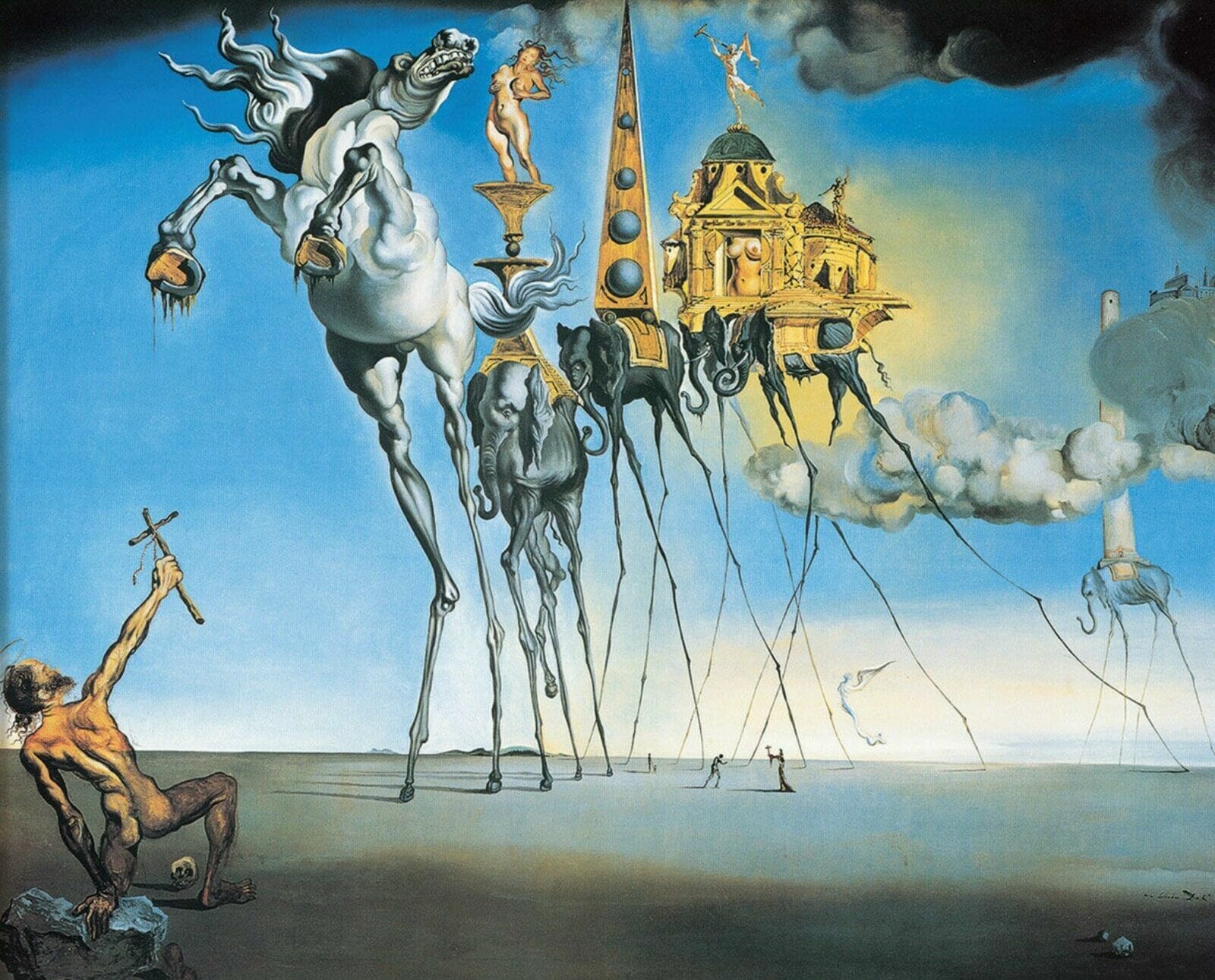
Callum is dragged further into unpacking what these cards mean. They offer him a gateway to exploring what life is about, or more specifically, what makes him him. He starts to feel more comfortable with the various uncertainties in life, yet realises that in this comfort there is more to battle. This is, the paradoxical journey of navigating the ego. But at this point, he is starting to understand that the ego can be split into pieces, and dealt with in various ways. For every part of the ego that has its unique way of causing harm, there is unique wisdom that can turn that harm into personal growth and understanding.
For the first time, Callum’s vulnerability is revealing the beginnings of insight. The very elaborate and emotionally charged painting of Dalí fits the experience he is having. The imagery of Dalí contains fragments of seductive power and beauty. They are all a part of being human, no matter how surreal we perceive them to be. How to balance indulgence and diligence? It is the catalyst for Callum to start taking actions, confront the magic of life, and to open his mind.
Summer – 1964
Artist: Agnes Martin

The first major profound experience Callum has is when in the throes of love. It is not uncommon for people to have awakenings when in the deepest moments of intimacy. Callum is, at this stage, not in tune with any sort of ‘metaphysical stuff’ appearing to him, or him to it. Instead, he describes the experience as a minimalist image, four different coloured squares in his mind's eye, with white dots in the center of each square. It is like how Mark Rothko painted, but more so like Agnes Martin, who took inspiration from him. Also like Rothko, Martin discovered a Zen-like liberation in stripping the mind of thought, and to depict that in her work.
Simple shapes and colours represent raw, primordial experience. They can take one into, and out of, enlightenment. Agnes Martin had an uncanny way of organising the organic. In her work Summer, she employs one colour, blue, and adds variation of light and shade. When we truly see life, we recognise its patterns, but see that the pattern changes subtly. Our passing moment to moment perception gives it structure. Frames it. The ‘grids,’ horizontal and vertical lines that Martin painted over large masses of colour, describe this experience. It allows the mind to relinquish, absorbing everything; but also doing nothing with it. In that, the mind is inseparable from its experience.
The Empty Form
As life appears to us, we are just seeing images. As thoughts arise, behind the story, are more images. Plays of light. From this, form takes shape. Form can eventually become very detailed and differing (like Bosch), or like Munch blurred and burdening, but also sometimes gross mass, and almost never-changing. The imagery of life is life beyond words. A wordless story. And it is our most direct path into emotion, and further, into the heart of divinity. Nothing special about it. Just simple purity. This brief evolution of experience that Callum has, through these five paintings, provides him with a glimmer into the layers of the mind’s manifestations.
Of course, Callum in no way had the words to describe this experience. And it would be many years later, through meditation, and intimate connection with the self, with others, with Nature, that this simple understanding of formlessness being held in form, somehow became a comforting notion for him – of the sacred that co-exists within our everyday world.
Next time you see something, notice how it is arranged in a certain way. Admire the repetition. If you look close enough, you will see that it has varying degrees of variation. The grain in wood. The thin veil of clouds that drape the sky. An insect crawling to who knows where, and who knows why. The elevation of your heart-rate as you increase your pace. In all of this, there is life. There is wonder. This is what cracks the mind completely open, into freedom from the overwhelming demands of life. Just noticing what is around you.
This post will be free to listen and read for 4 weeks. To access all posts at any time, please consider a paid subscription. Click here for more
Header image: Drawing and design by me.

Comments ()